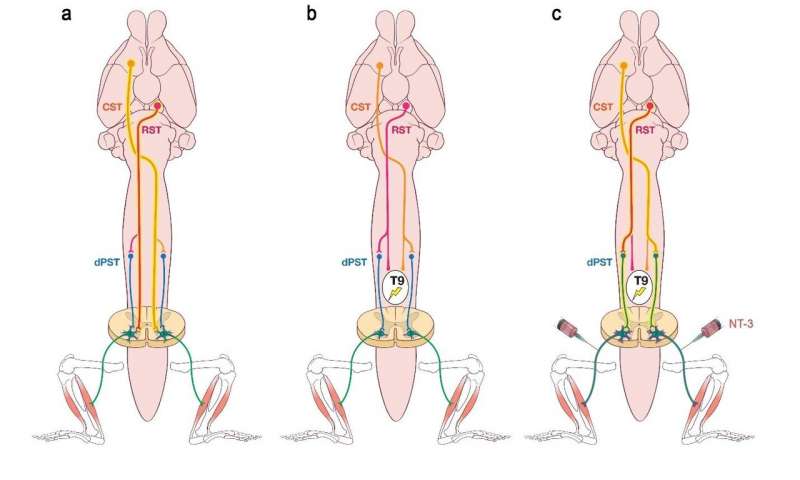Source: Thailand Medical News Dec 21, 2019 5 years, 4 months, 5 days, 3 hours, 6 minutes ago
Medical researchers at Indiana University School of Medicine have made several novel discoveries in the field of spinal cord injuries (SCI) and most recently, the team led by Dr Xiao-Ming Xu, Ph.D., has been working to determine how to activate movement after a spinal cord injury at the ninth thoracic level, where nerve fibers from the brain down to the spinal cord are interrupted. Instead of focusing on the injury site, researcher Dr Qi Han and his colleagues modulated the spared lumbar circuits below the injury to improve recovery from SCI, using animal models.
 (a) Both lumbar MNs and higher motor centers, including the corticospinal (CST), rubrospinal (RST) and descending propriospinal (dPST) tracts, are required to initiate and maintain locomotor function in normal conditions.(b) Thoracic contusions at T9 abolish the CST and RST, but spare the dPST projections below the injury, leading to lumbar motoneuron (MN) dendritic atrophy and locomotor dysfunction. (c) Modulation of propriospino-MN circuits by neurotrophin-3 (NT-3) gene therapy with a peripheral delivery route relays the supraspinal commands from the CST and RST down to the lumbar cord that enables locomotor recovery. Credit: IU School of Medicine
(a) Both lumbar MNs and higher motor centers, including the corticospinal (CST), rubrospinal (RST) and descending propriospinal (dPST) tracts, are required to initiate and maintain locomotor function in normal conditions.(b) Thoracic contusions at T9 abolish the CST and RST, but spare the dPST projections below the injury, leading to lumbar motoneuron (MN) dendritic atrophy and locomotor dysfunction. (c) Modulation of propriospino-MN circuits by neurotrophin-3 (NT-3) gene therapy with a peripheral delivery route relays the supraspinal commands from the CST and RST down to the lumbar cord that enables locomotor recovery. Credit: IU School of Medicine
The research team revealed that neuromodulation of interrupted lumbar motor circuits by neurotrophic therapy improved locomotor performance. These findings are published in the December 20 issue of
Nature Communications.
Dr Han told
Thailand Medical News, "There are no definitive treatments yet for SCI patients. However, hope for restoring motor function continues to rise, for good reason. We find that, despite no direct damage from thoracic SCI, the lumbar circuit undergoes a profound neurodegeneration, which we have highlighted as a promising new therapeutic target for promoting neuroprotection."
Spinal Cord Injuries disrupts pathways at the injury site and affects MNs by causing their dendrites to withdraw or atrophy below the injury, which can lead to diminished movement or locomotor function. Previously, the research team was able to improve locomotor recovery and reduce MN dendritic atrophy after a moderate, contusive SCI at the ninth thoracic level, by transporting Neurotrophin-3 (NT-3) to lumbar MNs. NT-3 is known as a trophic factor that contributes neuronal survival and growth. These latest research findings extend the role of NT-3 to modulating propriospinal-MN circuit reorganization, which accounts for improvement of locomotor function after SCI.
Medical researchers were also able to determine that a moderate injury at the ninth thoracic level stops the corticospinal tract and rubrospinal tract projections down to the spinal cord, but maintains some neural transmissions which can be reinforced by the NT-3 therapy. Additionally, they discovered the spared pathway, made up of a collection of nerve fibers, namely, the descending propriospinal pathway, connecting to the lumbar spinal cord, is functionally associated with NT-3-mediated locomotor recovery after SCI. Their research also suggests that NT-3 supports MN recovery by promoting dendritic regrowth.
Dr Xu says he hopes their research findings in animal models will lay the groundwork for
more NT-3 therapy research to help patients with SCI in the future.
Dr Xu added, "Modulating propriospinal-MN circuitry with NT-3
gene therapy could be an attractive strategy to enable functional recovery after SCI."
Reference : Qi Han et al, Descending motor circuitry required for NT-3 mediated locomotor recovery after spinal cord injury in mice, Nature Communications (2019). DOI: 10.1038/s41467-019-13854-3
